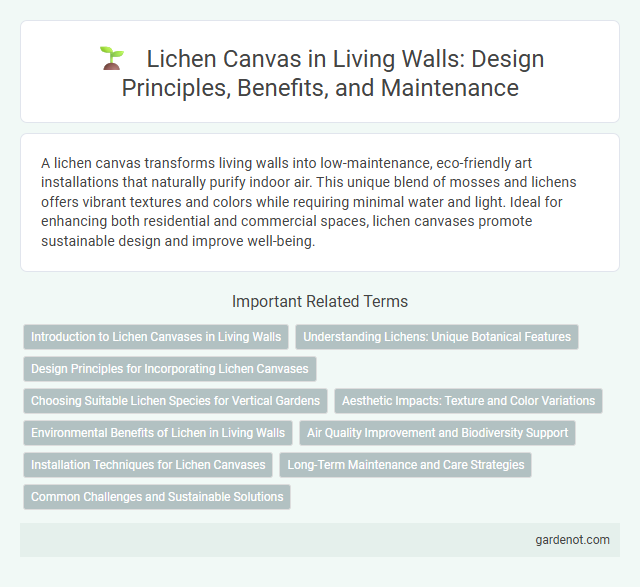A lichen canvas transforms living walls into low-maintenance, eco-friendly art installations that naturally purify indoor air. This unique blend of mosses and lichens offers vibrant textures and colors while requiring minimal water and light. Ideal for enhancing both residential and commercial spaces, lichen canvases promote sustainable design and improve well-being.
Introduction to Lichen Canvases in Living Walls
Lichen canvases offer an innovative approach to living walls by utilizing resilient, low-maintenance lichen species that thrive without soil or direct sunlight. These canvases provide natural air purification and enhance indoor aesthetics with their unique textures and muted green tones. Ideal for sustainable interior design, lichen living walls optimize humidity regulation and require minimal watering, making them eco-friendly and cost-effective.
Understanding Lichens: Unique Botanical Features
Lichen canvas showcases the symbiotic union of fungi and algae, forming a resilient, slow-growing organism that thrives in diverse environments. Their unique botanical features include a complex structure composed of fungal filaments intertwined with photosynthetic algae or cyanobacteria, enabling efficient nutrient absorption and moisture retention. This natural adaptability and minimal maintenance make lichens ideal for sustainable living walls, contributing to air purification and aesthetic appeal.
Design Principles for Incorporating Lichen Canvases
Design principles for incorporating lichen canvases into living walls emphasize balance between aesthetics and environment by selecting lichen species suited to light and humidity conditions. The texture and natural color variation of lichens create visually engaging patterns while promoting biodiversity and air purification. Strategic placement enhances wall durability and maintenance by allowing natural growth without overcrowding or moisture retention issues.
Choosing Suitable Lichen Species for Vertical Gardens
Selecting suitable lichen species for vertical gardens involves evaluating factors such as light tolerance, moisture retention, and air quality adaptation. Species like Cladonia, Cetraria, and Evernia are ideal due to their resilience in varying humidity and ability to thrive on minimal soil substrates. Incorporating these lichen types enhances the aesthetic and environmental benefits of living walls by promoting biodiversity and natural air filtration.
Aesthetic Impacts: Texture and Color Variations
Lichen canvas enhances living walls with rich texture and dynamic color variations, creating a visually captivating surface that evolves over time. The natural interplay of green, gray, and subtle earth tones provides depth and dimension, fostering a unique, organic aesthetic. Its ability to thrive in low-light environments ensures consistent vibrancy, making it an ideal material for artistic and biophilic design installations.
Environmental Benefits of Lichen in Living Walls
Lichen canvases in living walls enhance urban air quality by naturally absorbing pollutants and producing oxygen, contributing to healthier environments. Their ability to retain moisture reduces building energy consumption through improved insulation and temperature regulation. Lichens also support biodiversity by providing habitat for microorganisms, promoting ecological balance in urban settings.
Air Quality Improvement and Biodiversity Support
Lichen canvas on living walls significantly enhances air quality by naturally filtering pollutants and absorbing airborne toxins, contributing to healthier indoor and urban environments. This unique biological layer supports biodiversity by providing habitat for microfauna and promoting microbial diversity, fostering a balanced ecosystem. Its low-maintenance nature and ability to thrive in various conditions make lichen an eco-friendly solution for sustainable building design.
Installation Techniques for Lichen Canvases
Lichen canvases are installed using mounting systems that ensure stability and air circulation, such as wooden frames, metal grids, or adhesive backings specifically designed for delicate lichen preservation. Proper preparation includes cleaning and securing the substrate to support moisture retention and prevent mold while maintaining the natural texture and appearance of the lichen. Techniques emphasize minimal disturbance to the lichen, using gentle fastening methods and regular humidity control to sustain health and longevity in interior living wall applications.
Long-Term Maintenance and Care Strategies
Lichen canvas installations require minimal long-term maintenance due to their natural durability and resistance to pests and mold. Regularly dusting with a soft brush and avoiding direct exposure to sunlight or excessive moisture ensures the preservation of their vibrant appearance. Implementing proper indoor humidity control further extends the lifespan of lichen walls, maintaining their aesthetic and air-purifying benefits.
Common Challenges and Sustainable Solutions
Lichen canvas living walls often face challenges such as humidity control, light requirements, and maintenance complexity due to their delicate nature. Sustainable solutions include using natural, moisture-retentive substrates, incorporating recycled materials for frames, and optimizing indoor microclimate with LED grow lights that mimic natural sunlight. These approaches enhance lichen vitality while minimizing environmental impact and resource consumption.
Lichen canvas Infographic

 gardenot.com
gardenot.com